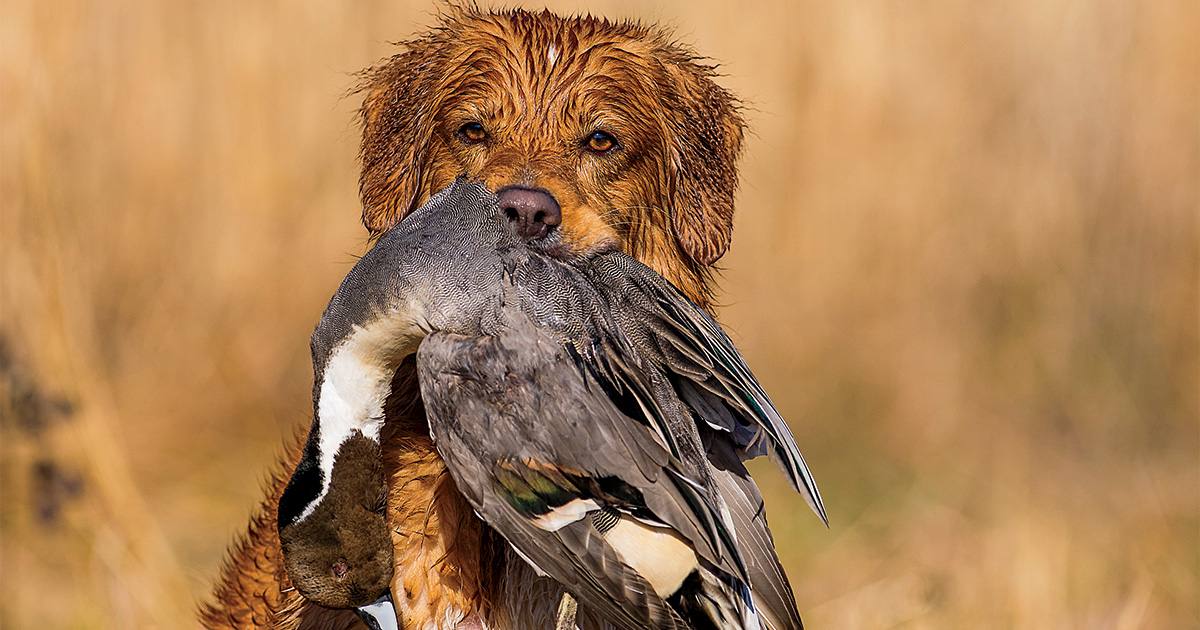The Nova Scotia Duck Tolling Retriever
Originally bred to lure curious ducks into gun range, today’s “tollers” are intelligent, athletic, and versatile hunters
Originally bred to lure curious ducks into gun range, today’s “tollers” are intelligent, athletic, and versatile hunters


Like a fox: The Nova Scotia duck tolling retriever is a capable hunter with a fascinating history.
When you get right down to it, there are three main tasks that we ask bird-hunting dogs to do—retrieving, flushing, and pointing. Some dogs are specialists, excelling at one of these skills. Others are multitaskers.
And then there’s the Nova Scotia duck tolling retriever. It’s a retriever, yes, but it was developed to perform an additional and altogether unique function—to “toll” or lure rafted ducks into range. How does this work? Ducks, for reasons known only to them, are fatally attracted to the sight of red foxes noodling around on a shoreline. The ducks will often approach for a closer look. The foxes figured this out long ago, and they turned it to their advantage by working in pairs: one fox would caper about in plain sight while another fox hid in the bushes, waiting to pounce on the curious ducks.
Observant sportsmen took a page from the foxes’ book and began using small, reddish dogs to toll in rafted ducks, throwing sticks (or whatever was handy) to keep the dogs in constant motion up and down the shore. By the early 1800s, the use of tolling dogs was fairly common among waterfowlers on Maryland’s Eastern Shore.
The sportsmen of Nova Scotia took the final step and developed a dog tailored specifically for tolling. This dog’s ancestors are a matter of conjecture—various sources credit everything from Chesapeake Bay retrievers to Irish setters to collies to the dogs of Nova Scotia’s indigenous Micmac people. By 1900 or so the basic type of the Nova Scotia duck tolling retriever had been established. The breed earned Canadian Kennel Club recognition in 1945, and the American Kennel Club recognized it in 2003.
While still relatively uncommon, the “toller” is growing in popularity, says Dan Kauzlarich of Beekauz Kennels in Farmington, Illinois. And, under the right conditions, these dogs can still perform the specialized role that gave the breed its name.
“You have to have ducks rafting on open water,” Kauzlarich explains, “and you have to have a stretch of open, well-defined shoreline. Ideally you want the ducks rafted no more than 100 yards from shore. Then, you basically play fetch with your dog. You can throw a ball, a bumper, a stick—anything.”
As retrievers, these dogs have the drive, desire, athleticism, tenacity, and cold-weather tolerance to perform commendably in just about any traditional waterfowling situation. Kauzlarich hunts his tollers everywhere from the big water of Devils Lake, North Dakota, to the extensive marshlands of Cheyenne Bottoms in Kansas—and in setups that range from 500 decoys to just a handful—and never feels “underdogged.”
Kauzlarich admits that there’s a limit to how far he’ll ask his tollers to go. “When I send a dog for a retrieve,” he says, “I want the duck and the dog back ASAP. Once you start talking 150-yard-plus retrieves, I say, ‘That’s what the boat’s for.’”
“One of the reasons it’s difficult to compete successfully at a high level in hunt tests with tollers is that they can’t take the high-pressure training necessary to do long-distance blind retrieves,” Kauzlarich says. “If you pressure them too much, or submit them to too much repetition, they shut down. They’re very intelligent, but they’re soft, so you have to take your time and be patient. A good training session for a toller might be three or four reps. At that point, you should call it a day.”
Tollers are capable upland flushing dogs, too, Kauzlarich notes, with good noses and a naturally close-working style. “They’re hunting dogs,” he says. “There’s a lot of versatility built into the breed’s blueprint.”
In many respects, says Kauzlarich, the toller resembles a smaller, stockier version of the golden retriever. The physical similarities are obvious, although the toller’s coat can be a little more fawn-colored than the golden’s and also splashed more extensively with white on the chest and muzzle. Like the golden, the typical toller is a friendly, happy, animated fellow who thrives in a family environment.
Don’t expect a toller to hang on your every move, though. “They’re pretty independent,” Kauzlarich explains. “They’re not the kind of dogs that demand you pet them all the time. With tollers, a little affection goes a long way.”